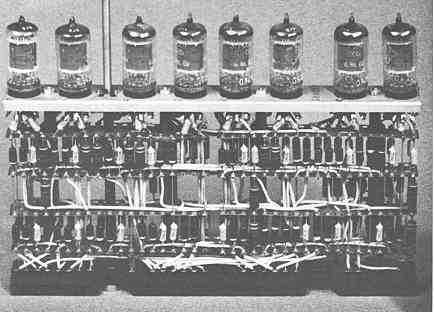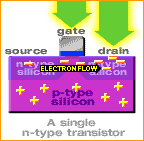MCS-170 The Nature of Computer Science
Fall 2006
Lecture 16
1. Chapter 16 - Logic Circuits and Switches
- We have looked at the technological side of computing from a Macro to a Micro level:
- The Internet and the World Wide Web ( packet switching,
routers, TCP/IP)
- Structure of a single computer: CPU, I/O, and Memory
- Structure of the CPU: ALU,
CU, and Registers (all built from logic
circuits)
- Now -- Logic Circuits
- Logic
Circuit -- circuit that
controls the flow of electricity
- Electricity
-- flow of electrons through a conducting material
- Flow
"ON" - represents a binary
value of 1, or a logical value
of TRUE
- Flow
"OFF" - represents a binary value of 0, or a logical value of FALSE
- So,
Logical Circuit is
essentially a sophisticated Switch
2. Switches
- A switching circuit
can be as
simple as a switch connected in series with a lamp. But when you have a
switch connected in series with another switch and/or connected in
parallel
with another switch, then you create a logic circuit that will function
to turn on the lamp depending on how the switches are arranged and
connected
and what results when certain switches are closed or open.
- Example - Switches A and
B represent logical values, A and B can be closed or open (1 or 0) (T
or F). The power supply (lower left component) supplies the
current and the light bulb (circle with inside circle) shows the output
of the switch (lit = 1).
- The CPU of a computer
can be entirely constructed from such simple circuits! But, millions of
wall switches would be quite something to control
- Earliest
computer (~1930) used electric
relays for switches. Such switches are controlled by
voltage to a magnet. We can use a common power
source by connecting the positive and negative terminals. We can also
assume a common "ground" ("earth" in
non-American English) for the negative terminals and use "V" (voltage
source) for the positive terminal. The power source for the relay can
then be the output of another circuit! In this way we can automate the operation of logic
switches
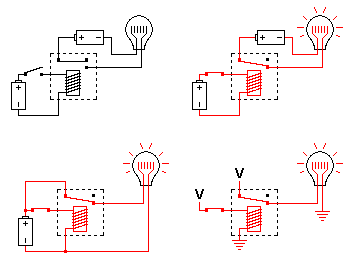
- In the above relay circuit, the switch is open by default. We
could reverse this and have a relay that is by default closed. If the
switch on the relay is labeled "P" then
when P is TRUE the bulb is extinguished; we could say that the bulb is
FALSE,
or NOT P.
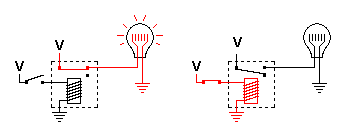
- Generation
0 Computers (1940's) - Vacuum
Tubes as switches. Tubes could control current, just like a
relay, but could switch on and off much faster. However, they generated
lots of heat and burned out frequently.
3. Transistors (Generation 1 Computers)
- 1948 -- Bardeen, Brattain, and
Shockley invented the transistor. Pure
silicon, the base material of most
transistors, is considered a semiconductor
because its conductivity can
be modulated by the introduction of impurities.
- Silicon containing boron impurities is
called p-type silicon-p for
positive or lacking electrons. Silicon containing
phosphorus impurities is called n-type
silicon-n for negative or having
a majority of free electrons.
Transistors consist of three terminals: the source, the gate, and the drain. (Images from Intel web site)
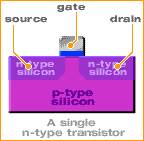
- In the n-type transistor, both the source
and the drain are negatively
charged and sit on a positively charged well of p-silicon.
When positive voltage is applied to the gate, electrons in the
p-silicon are attracted to the area under the gate, forming an electron
channel between the source and the drain.
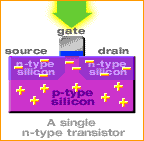
- This opens the flow from the drain to the
source, so that when a positive voltage
is applied to the drain, the
electrons are pulled from the source to the drain. In this state the
transistor is on.
- Advantages -- Reduced
Size, Reduced Power Consumption, Reduced Heat, Low Maintanance
4. Transistors as Building Blocks of Logic Gates
- Combinations of NMOS and PMOS transistors can be used in sequence
(connecting output of one to input of another) to produce signals that
are functions of the input.
- Example -- A Logical NOT
circuit (overhead)



